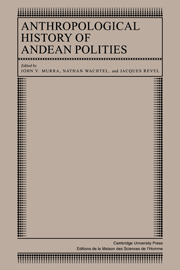Book contents
- Frontmatter
- Contents
- List of contributors
- Preface
- Introduction
- Part I Ecology and society
- 1 The tropical Andes: a changing mosaic
- 2 The evolution of a valley: population and resources of Tarapacá over a millennium
- 3 “Horizons” in Andean archaeology
- Part II The ethnic group and the state
- Part III Systems of classification
- Part IV Symbolic representations and practices
- Part V From ethnic polities to communities
- Bibliography of published source
- Index
1 - The tropical Andes: a changing mosaic
Published online by Cambridge University Press: 05 October 2010
- Frontmatter
- Contents
- List of contributors
- Preface
- Introduction
- Part I Ecology and society
- 1 The tropical Andes: a changing mosaic
- 2 The evolution of a valley: population and resources of Tarapacá over a millennium
- 3 “Horizons” in Andean archaeology
- Part II The ethnic group and the state
- Part III Systems of classification
- Part IV Symbolic representations and practices
- Part V From ethnic polities to communities
- Bibliography of published source
- Index
Summary
The Andes are the most imposing mountain mass in the tropics. Those who live there have for millennia made full use of the possibilities offered by an ecological mosaic utilizable from sea level to an altitude of around 4,500 meters. The spatial organization of Andean society is rooted in this ecological diversity, but this mosaic has itself altered over time, in response either to climatic change or to human activity. Ecology is in fact variously interpreted, depending on the techniques available from the space and on the aims of the particular society. We must therefore consider how, in the Andes, space acts as a material constraint upon social organization, and how the ecological mosaic is exploited, experienced, and perceived.
Ecological diversity
The richness of the ecological mosaic may be attributed to the strips of land being ordered in a succession of tiers, explicable in terms of the drop in temperature accompanying a rise in altitude. The alternation of damp and dry, sloping and horizontal, forested and deforested, and the presence or absence of human planning further complicate the mosaic. There are in fact several hundred basic physiognomical units, or “geofacies,” in the tropical Andes, whereas the Alps can lay claim to only a few dozen and the mountains of the far north to fewer then ten. This opulence permits a large number of possible ecological combinations, some of which, in the course of history, the Andean societies have adopted.
- Type
- Chapter
- Information
- Anthropological History of Andean Polities , pp. 11 - 22Publisher: Cambridge University PressPrint publication year: 1986



